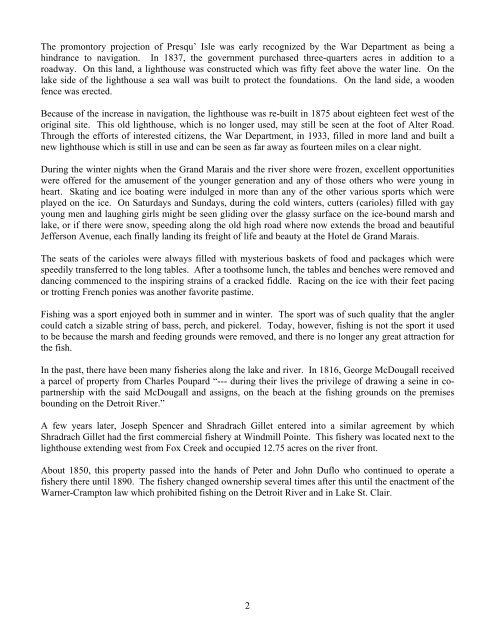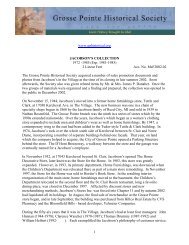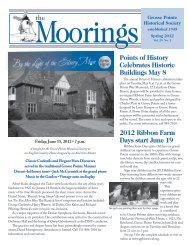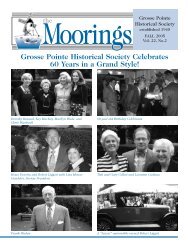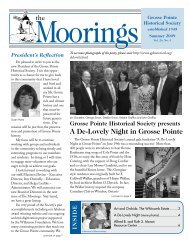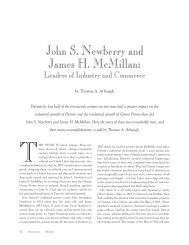The Grand Marais - Grosse Pointe Historical Society
The Grand Marais - Grosse Pointe Historical Society
The Grand Marais - Grosse Pointe Historical Society
You also want an ePaper? Increase the reach of your titles
YUMPU automatically turns print PDFs into web optimized ePapers that Google loves.
<strong>The</strong> promontory projection of Presqu’ Isle was early recognized by the War Department as being a<br />
hindrance to navigation. In 1837, the government purchased three-quarters acres in addition to a<br />
roadway. On this land, a lighthouse was constructed which was fifty feet above the water line. On the<br />
lake side of the lighthouse a sea wall was built to protect the foundations. On the land side, a wooden<br />
fence was erected.<br />
Because of the increase in navigation, the lighthouse was re-built in 1875 about eighteen feet west of the<br />
original site. This old lighthouse, which is no longer used, may still be seen at the foot of Alter Road.<br />
Through the efforts of interested citizens, the War Department, in 1933, filled in more land and built a<br />
new lighthouse which is still in use and can be seen as far away as fourteen miles on a clear night.<br />
During the winter nights when the <strong>Grand</strong> <strong>Marais</strong> and the river shore were frozen, excellent opportunities<br />
were offered for the amusement of the younger generation and any of those others who were young in<br />
heart. Skating and ice boating were indulged in more than any of the other various sports which were<br />
played on the ice. On Saturdays and Sundays, during the cold winters, cutters (carioles) filled with gay<br />
young men and laughing girls might be seen gliding over the glassy surface on the ice-bound marsh and<br />
lake, or if there were snow, speeding along the old high road where now extends the broad and beautiful<br />
Jefferson Avenue, each finally landing its freight of life and beauty at the Hotel de <strong>Grand</strong> <strong>Marais</strong>.<br />
<strong>The</strong> seats of the carioles were always filled with mysterious baskets of food and packages which were<br />
speedily transferred to the long tables. After a toothsome lunch, the tables and benches were removed and<br />
dancing commenced to the inspiring strains of a cracked fiddle. Racing on the ice with their feet pacing<br />
or trotting French ponies was another favorite pastime.<br />
Fishing was a sport enjoyed both in summer and in winter. <strong>The</strong> sport was of such quality that the angler<br />
could catch a sizable string of bass, perch, and pickerel. Today, however, fishing is not the sport it used<br />
to be because the marsh and feeding grounds were removed, and there is no longer any great attraction for<br />
the fish.<br />
In the past, there have been many fisheries along the lake and river. In 1816, George McDougall received<br />
a parcel of property from Charles Poupard “--- during their lives the privilege of drawing a seine in copartnership<br />
with the said McDougall and assigns, on the beach at the fishing grounds on the premises<br />
bounding on the Detroit River.”<br />
A few years later, Joseph Spencer and Shradrach Gillet entered into a similar agreement by which<br />
Shradrach Gillet had the first commercial fishery at Windmill <strong>Pointe</strong>. This fishery was located next to the<br />
lighthouse extending west from Fox Creek and occupied 12.75 acres on the river front.<br />
About 1850, this property passed into the hands of Peter and John Duflo who continued to operate a<br />
fishery there until 1890. <strong>The</strong> fishery changed ownership several times after this until the enactment of the<br />
Warner-Crampton law which prohibited fishing on the Detroit River and in Lake St. Clair.<br />
2


